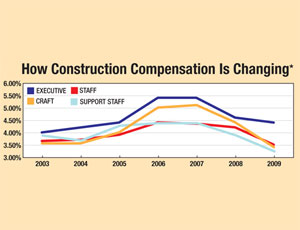As President Obama’s multibillion-dollar stimulus package becomes law, one thing is clear: thousands of construction workers will be helping to transform the American economy and landscape. Still, employment worries continue to be a source of concern.

"The nearly one million construction workers who have lost their jobs across the country have a renewed chance of success with passage of the stimulus legislation," says Stephen E. Sandherr, CEO, Associated General Contractors of America, Arlington, Va. "The construction investments will help save or create hundreds of thousands of jobs and give tens of thousands of companies an opportunity to survive these tough economic conditions while building a strong foundation for future economic growth." On the downside, he notes cutting $20 billion of needed school construction in the Senate version reduced the number of jobs created or saved by over 340,000.
Contractors appear to be united with labor on the is- sue. "The economic recovery plan...is a step forward but falls short of the opportunity to put millions of jobless men and women back to work building America," says Jacob Hay, spokesman for the Laborers’ International Union of North America.
Hay notes a recent report by the Labor Dept.’s Bureau of Labor Statistics that shows unemployment in the construction industry at 18.2%, with over 1.7 million construction workers out of work. "The economic recovery plan, as it currently stands, will create between 600,000 and 700,000 construction jobs it is a good start, but it leaves over one million construction workers looking for a job," says Hay. "Investments for creating jobs that build America in the recovery plan are less than 20% of the total package, and resources for job creation have been crowded out by tax cuts and voted down in amendments."
While the industry is ready, there are some reservations. "Our members are poised to react to the infrastructure portion of the stimulus," says Jerry Gorski, national chairman of the Associated Builders and Contractors Inc., Arlington, Va., and president of Gorski Engineering, Collegeville, Pa. However, ABC, which represents 25,000 members employing nearly 2 million construction craft professionals, is strongly opposed to a Feb. 6 presidential executive order reinstating union-only project-labor agreements on federal work over $25 million. "PLA’s discriminate against 84% of the construction workforce," says Gorski. "If one goal of the stimulus is to put people back to work, then why do we need PLA’s? [They] not only restrict the workforce but also the number of contractors bidding for the work. We need to get the most bang for the buck, so why restrict competition and raise prices?"
Tom Owens, director of marketing and communications for the AFL-CIO’s Building & Construction Trades Dept., Washington, D.C., disagrees. "The Bush anti-PLA executive order was exactly the type of special-interest-driven politics and policy that American voters rejected overwhelmingly last November. This administration recognizes that PLAs are designed to provide maximum benefit to construction users, union and nonunion workers, union and nonunion contractors, lenders and insurance companies and taxpayers." He also notes that America’s building trades unions are pleased with the economic-stimulus conference report. "This bill is truly a dramatic and much-needed investment in America’s economic health" he says.
PLA or not, most construction firms plan compensation increases this year for employees. "We just finished our 2009 executive compensation survey and in general firms were anticipating between 3.7% and 4.3% increases at the top level," says Jeffrey M. Robinson, president of PAS Inc., Saline, Mich. "Professional staff and middle managers will get between 3% to 3.5%, open-shop craft about 3% to 3.4% and administrative support staff between 2.7% and 3.2%."
Robinson notes that these figures are somewhat less than previous years.


Post a comment to this article
Report Abusive Comment